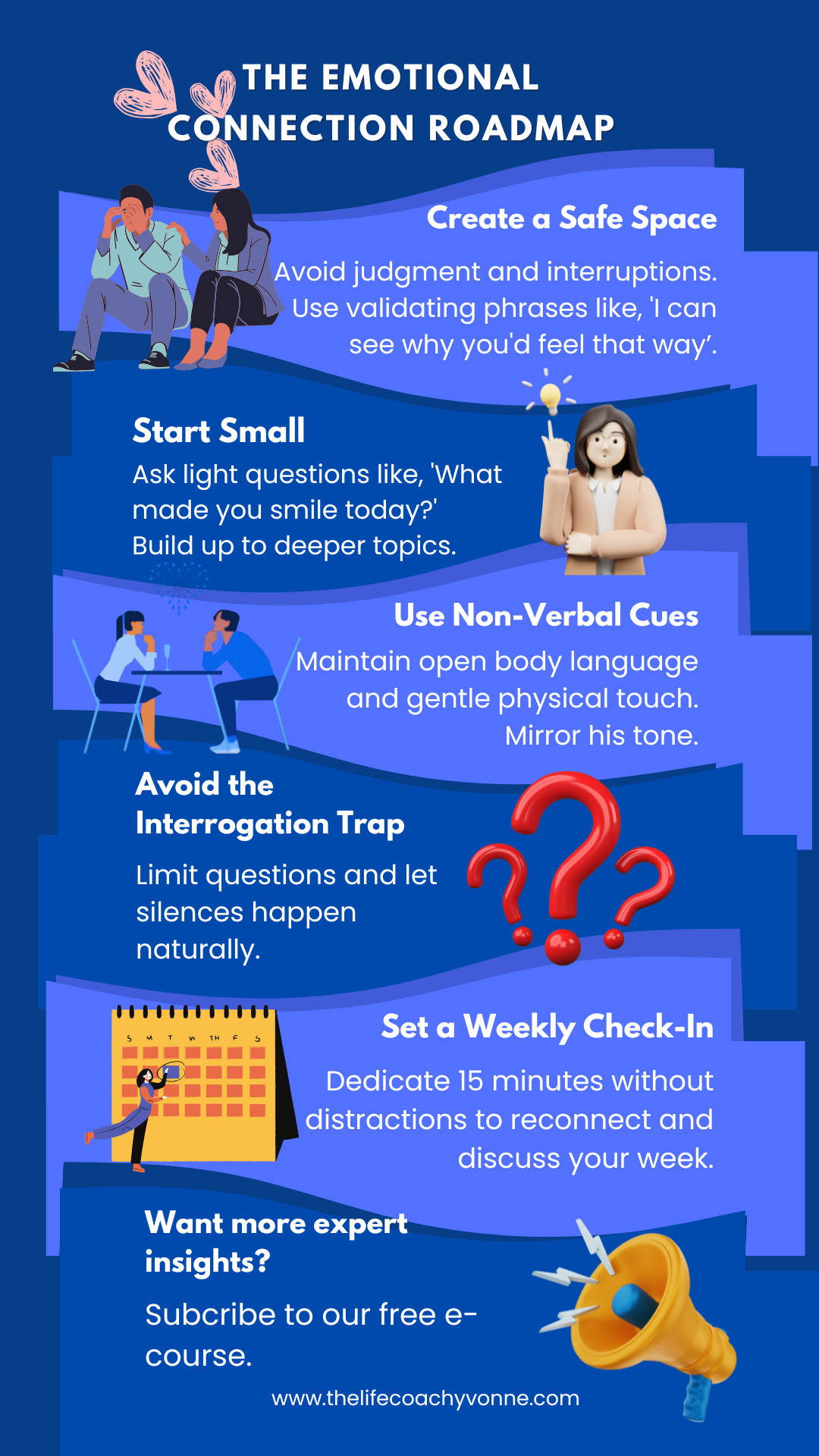How Can I Get My Husband to Open Up Emotionally?

Because sometimes getting him to talk is harder than getting the kids to eat broccoli.
The Emotional Mystery of Husbands

We’ve all been there—sitting across from our husbands, asking a heartfelt question, only to receive a shrug or the dreaded “I’m fine.” But here’s the truth: many men aren’t naturally wired to express their emotions openly.
Cultural norms, upbringing, and personality all play a role.
But don’t lose hope! With patience, understanding, and the right approach, you can create an environment where your husband feels safe enough to share his thoughts and feelings.
This guide will show you how, with practical steps and insights that have worked for many wives (myself included).
Why Husbands Struggle to Open Up

Before diving into solutions, it’s essential to understand why your husband might be emotionally reserved.
1. Societal Conditioning
From a young age, many boys are taught that showing emotions is a sign of weakness. Phrases like “Man up!” and “Boys don’t cry” leave lasting impressions.
2. Fear of Judgment
Some men worry that being vulnerable will make them seem less capable or strong in their partner’s eyes.
3. Lack of Emotional Vocabulary
Unlike women, who often grow up discussing feelings, men may not have the vocabulary to articulate their emotions.
Step-by-Step Guide to Getting Your Husband to Open Up

1. Create a Safe Environment

If your husband fears being judged or misunderstood, he won’t open up.
How to Do It:
- Avoid interrupting or offering solutions immediately.
- Validate his feelings with phrases like “I can see why you’d feel that way.”
- Keep your tone calm and non-confrontational.
Pro Tip:
Pick the right setting. Many men find it easier to talk during activities like walking, driving, or cooking together rather than sitting face-to-face.
2. Start Small
Diving straight into deep conversations can be overwhelming.
How to Do It:
- Ask light, open-ended questions: “What was the best part of your day?”
- Gradually build up to more meaningful topics as he becomes comfortable.
Example:
One evening, instead of asking my husband a heavy question about work stress, I simply said, “Tell me one thing that made you smile today.” That small question led to a surprisingly deep conversation.
3. Lead by Example
Be vulnerable yourself to set the tone for open communication.
How to Do It:
- Share your feelings openly but without overwhelming him.
- Use statements like “I was really nervous about that presentation today, but I felt proud when it went well.”
Why It Works:
According to PsychCentral.com, “Vulnerability fosters closeness, trust, and intimacy because it tells the person you’re with that you trust them. This allows you to truly get to know each other: how you think, what you value, and what you aspire to.”
In other words, by showing your husband that it’s safe to be open and vulnerable, you create an environment where he feels encouraged to do the same.
Quick Action:
Tonight, share one personal experience that made you feel proud, scared, or even uncertain. Then, simply ask, “Has anything like that ever happened to you?” and see where the conversation goes.
4. Use Non-Verbal Cues
Sometimes body language speaks louder than words.
How to Do It:
- Maintain open body language (no crossed arms or frowning).
- Make gentle physical contact, like holding his hand or touching his arm.
- Mirror his tone and posture to build subconscious rapport.
Related Content:
Want to learn more about decoding non-verbal cues? Check out The Top 5 Nonverbal Communication Cues Every Wife Should Know.
5. Avoid the Interrogation Trap
Bombarding him with questions will only make him retreat further.
How to Do It:
- Limit your questions to one or two per conversation.
- Let silences happen naturally without feeling the need to fill them.
6. Use “I” Statements Instead of Blame
Blaming language shuts down communication.
How to Do It:
- Instead of: “Why don’t you ever tell me how you feel?”
- Try: “I feel disconnected when we don’t talk about what’s going on in our lives.”
7. Encourage Non-Verbal Expressions of Emotion
Sometimes writing or creative activities can help men express feelings.
How to Do It:
- Suggest journaling or even sending texts if verbal conversations are tough.
- Engage in creative activities together, like painting or music, which can naturally evoke emotions.
Real-Life Example: The Silent Car Ride That Changed Everything

One Saturday, after noticing my husband was unusually quiet, I suggested a drive along a scenic route. We didn’t talk much at first, but after about 20 minutes, he opened up about a work issue that had been bothering him for weeks.
The takeaway? Creating a pressure-free environment works wonders.
Practical Tips for Busy Wives
- Set a Weekly Check-In: Dedicate 15 minutes to talk without distractions.
- Use a Conversation Jar: Fill it with fun and meaningful questions.
- Express Appreciation: Compliment his efforts to share, no matter how small.
FAQs About Emotional Connection in Marriage
Q1: What if my husband says he’s “fine” all the time?
Start with small, low-pressure questions and be patient. He may need time to open up.
Q2: How can I make him feel comfortable sharing his feelings?
Create a safe, non-judgmental environment and avoid offering solutions unless he asks.
Q3: What if he never wants to talk?
Encourage non-verbal forms of communication like writing or creative activities.
Q4: Can counselling help?
Absolutely. A trained therapist can provide tools for better communication. For personalized guidance book a coaching session.
Build Your Knowledge with Internal Resources
To dive deeper into improving communication and emotional connection in your marriage, explore these valuable resources:
- Improving Communication in Marriage — A comprehensive guide to strengthening communication and fostering a healthier, happier marriage.
- 10 Conversation Starters to Reconnect with Your Husband — Discover powerful conversation starters to deepen your connection and spark meaningful discussions.
Expert Advice from Trusted External Sources
Looking for more insights from industry-leading experts? Check out these reputable resources:
- American Psychological Association: Emotional Validation — Learn how validating emotions can reduce conflict and strengthen relationships.
- The Gottman Institute: Practical Listening Strategies — Explore proven techniques to foster better communication in your marriage.
Ready to Transform Your Marriage?
If you're serious about improving communication and creating a deeper emotional connection with your husband, I invite you to take the next step:
✅ Join our FREE 7-Day E-Course: “7 Days to Better Communication and Deeper Connection in Your Marriage”
You'll receive daily actionable lessons and practical tools to help you connect with your husband like never before.
💖 Work with Me for Personalized Marriage Coaching:
Get customized guidance tailored to your unique situation. Together, we’ll create a communication blueprint that strengthens your relationship and brings lasting joy.
Your best relationship is just one decision away!
